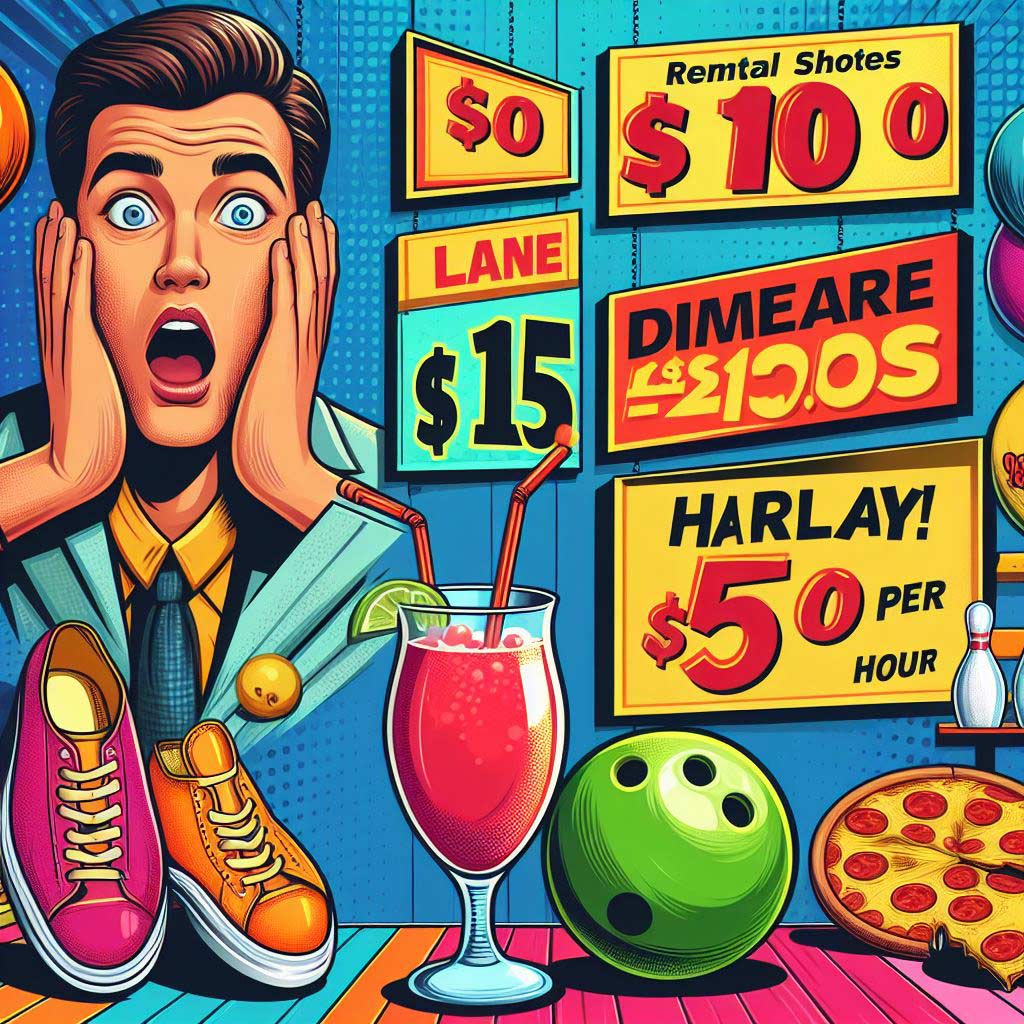Bowling is one of America’s most popular pastimes, with over 70 million people heading to the lanes every year. But between rental shoes, lane fees, balls, food, and drinks, how much does an evening of strikes and spares really cost?
As it turns out, pricing can range widely depending on where, when, and how extravagantly you bowl. A casual game at your local alley can be just a few dollars if you catch a good deal, while an exciting night out with friends at one of the new upscale bowling venues can quickly add up to $100 or more per person when all is said and done.
Below we’ll break down the typical costs for bowling and what key factors result in those wild pricing differences. By understanding the basics, you can better set expectations and budget for a fun and affordable trip rolling strikes. After all, bowling should be for everyone, not just the million-dollar players!
Bowling Alley Line Rates
The first big cost consideration for bowling is the price to rent a lane. This allows you and your group access to that lane for a set period of time.
Most traditional bowling alleys charge per game played, with rates typically ranging from $5 to $10 per game. Per-game pricing at some locations also includes shoe rental in that base fee.
Other centers may charge per hour instead, usually $10-$20 per lane depending on peak versus non-peak times. Per-hour pricing allows for more casual play rather than charging per full game.
In major metropolitan areas, rates for basic bowling can be $10 or more per game even at aging lanes, while modern centers with full bars, clubs, and food menus are going to hit the higher end at $15 per game or more.
That may seem steep compared to rural town bowling alleys that maintain those cheerful $5 game rates, but the location makes a difference. The same reasoning applies to posh boutique bowling joints that feel like swanky nightclubs. Their allure and amenities let them charge premium lane rental rates.
Peak vs Non-Peak Rates
Another key pricing factor is peak hours versus non-peak hours. Like everything else, when demand goes up, so do the prices.
Peak times when alleys fill up and charge the most are Friday and Saturday evenings. Meanwhile, least busy times are often weekdays before 5 pm. This means you can save almost 50% simply by opting to bowl at noon on a Tuesday instead of at 8 pm on a Friday.
Some locations now even implement “happy hour” style specials on normally peak nights but at earlier times, such as 5 to 7 pm Saturdays. Savvy bowlers grab those early bird special lane rates before the crowds pile in later.
Rental Shoe Costs
Okay, you’ve picked your lane and playing time. But don’t forget – unless you have your own special bowling shoes, you’ll need to factor in a few dollars for renting footwear.
Budget about $5 per player for standard rental shoe rates. However, newer or upscale bowling centers sometimes charge more for fancier shoe offerings, even up to $10 per player.
The good news is some establishments include shoe rental fees simply as part of the base lane pricing package. This appeals to casual bowlers who don’t want to fuss over mixing and matching costs.
One final tip is if you plan to bowl frequently or on a league, consider buying your own shoes. After six or seven shoe rentals the price usually evens out to owning your own dedicated pair.
Party and Group Event Rates
Bowling is always more fun with more people – but naturally costs rise as you add players into the mix. Lane rates themselves don’t increase per person, but bundled party and event packages change things.
Most alleys offer discounted group packages for birthdays, corporate events, youth groups, and more. These let you reserve full lanes at a fixed cost.
For example, a “Party Package” might run $100 total, covering a lane for two hours plus shoe rental, a large pizza, pitchers of soda, paper products, etc. If you split that with six friends it becomes $16-17 per person. Quite budget-friendly.
Group sizes, food and drink choices, add-ons like arcade cards, and days of the week all affect total package pricing. Mondays through Thursdays tend to have the best group rates, while Friday and Saturday lanes fill up fast. Call ahead if booking for six or more.
Food and Drink Costs
Food and drink tabs make up a significant portion of a night out bowling. Fortunately, the menu range appeals to almost any budget depending on your tastes.
Typical alley fare like greasy pizza, hot dogs, and nachos are always affordable. $20 feeds a group with a basic pie and cheesy chips.
For something healthier, newer bowling venues expand offerings with sandwiches, burgers, salads, and sometimes even sushi. Prices remain similar or run a little higher.
As for drinks, count on soda and juice for just a few bucks per game. But where things accelerate is at the bar. Craft brews or cocktails easily hit $10 to $15 each round. Order conservatively if watching expenses.
Bottomless pitchers for groups sometimes offer the best drinking value if planning a longer stay. Or designated drivers rejoice over free soda policies at certain family-friendly chains!
Of course with glow bowling, late nights, loud music, and flying balls, restraint isn’t always part of the scene. Which is understandable too! Just good to keep that wining and dining tab in check if on a tighter budget.
Regional and Seasonal Variations
Where bowling rates fluctuate the most is by region and by season. Some destinations price lanes significantly higher or lower than national averages.
Take New York City for example. Even standard bowling alleys easily top $15 per game and approach $40 per hour due to higher rents and operating costs. Add trendy bars and clubs into Manhattan lanes? Even a single game can creep towards $25 before shoes or food. Ouch!
Likewise, popular vacation areas like Hawaii, Vegas or Southern California bowling centers may upcharge thanks to steady tourist traffic. Hawaii in particular can be double or more normal pricing.
On the opposite pole are small-town bowling alleys where $7 per game never budged over the decades. Helps keep community camaraderie alive when the sport stays affordable to all.
Seasonally, bowling picks up when temperatures drop indoors. Summer months find many alleys half full except on rainy days. Savvy local bowlers hit the lanes in October through April to catch lower promotional rates that stay afloat amid slower seasons.
So What’s the Bottom Line Cost?
Given all those variables between rented lanes, shoe fees, food, and drinks, when everything aligns bowling can cost as little as $15 per person including shoes and budget eats.
Or the same experience skyrockets over $50 per head at high-end cocktail bowling joints. Split the difference around $25 per person covering two hours of play, shoe rental, and bar drinks averaging $10 each.
At the end of the day, bowling costs as much or as little as you want. With over 4,500 bowling centers nationwide, bargain rates hide amid the glitzy modern venues if seeking them out.
Factor when and where you play, then peruse group specials to cater towards sensible spending. All that matters is enjoying those strikes and laughter-filled moments together with family and friends.
After all, good company and conversation make any bowling outing priceless fun. The rest just helps set the scene!
Frequently Asked Questions
Why does bowling cost so much?
Bowling costs can add up due to lane rental fees, shoe rentals, food, and drinks. Additionally, upscale bowling venues invest in modern facilities, entertainment options, and full-service dining which gets passed on to customers through higher pricing. Peak weekend hours also drive rates up.
How many is a game of bowling?
A standard game of bowling is 10 frames, consisting of 10 pins set up at the end of the lane. Players take turns rolling balls down the lane trying to knock down all 10 pins per frame.
Is bowling a cheap sport?
Bowling can be a very affordable sport if you visit local alleyways during non-peak hours and avoid extras like food, drinks, and video games. However, costs add up quickly at upscale venues with amenities, making it less budget-friendly.
How long does it take for 5 people to bowl?
With 5 people taking turns in a traditional scoring bowling game, it typically takes 60-90 minutes total to complete just 1 game. This factors about 2 minutes per bowler per turn.
Is bowling an expensive sport?
Overall equipment, lessons, and lane access remain reasonably affordable compared to many other sports. However, bowling can still involve high per-game costs at flashy venues with modern lanes, drinks, and entertainment making for an expensive night out.
How many games are in a round of bowling?
While league and tournament play may involve multiple successive games, casual bowling typically considers just a single game as a complete round. Most non-competitive bowling is simply done game-by-game for fun rather than keeping score across frames.
Can two people go bowling?
Yes, bowling lanes accommodate anywhere from individual players up to 6 people or more. Two people make for affordable fun and friendly competition together.
How long does it take to bowl 1 game?
Bowling a single game with 2-4 casual players averages around 30-45 minutes in total. With more players waiting between turns, the pace slows with games taking 60+ minutes.
How many balls do you throw in bowling?
Bowlers throw two balls per frame in a standard 10-frame bowling game. So 20-21 total throws per complete game depending on if bonus throws occur in the 10th frame after strikes or spares.





